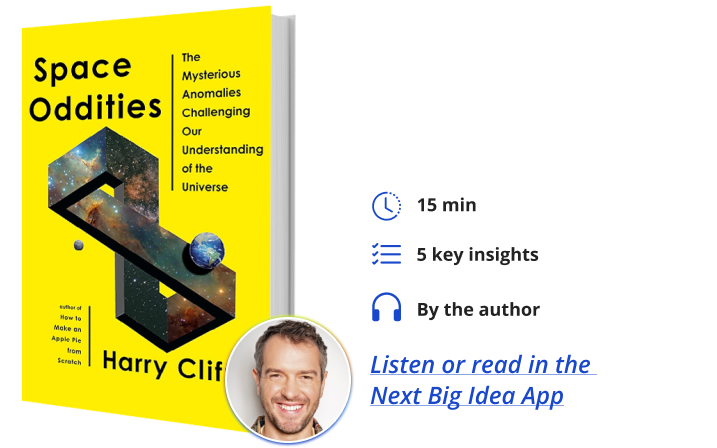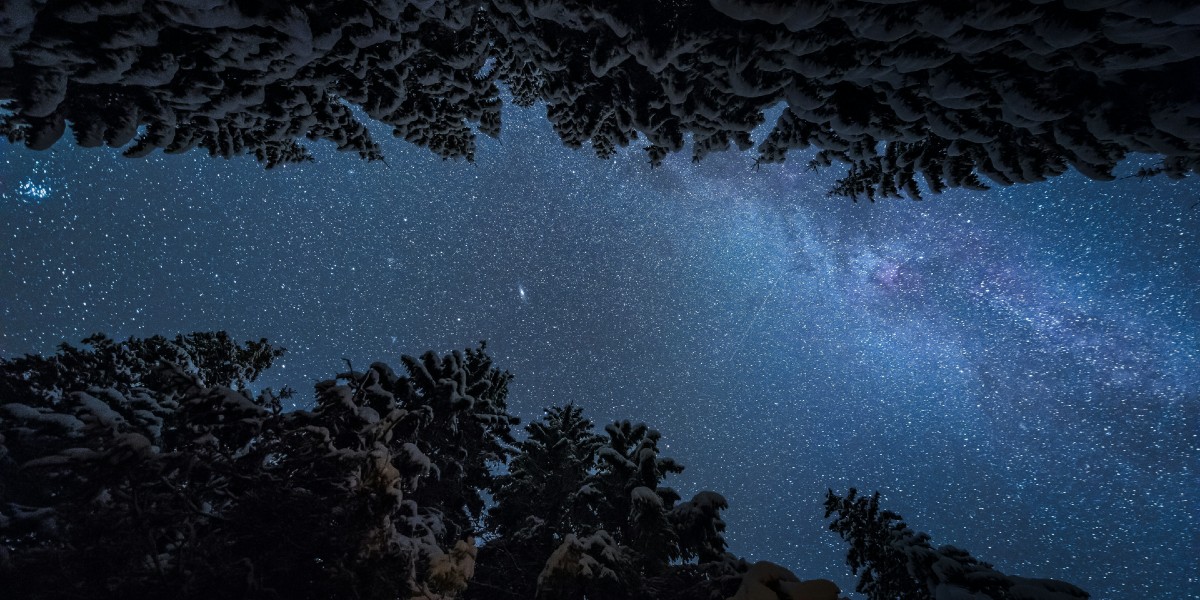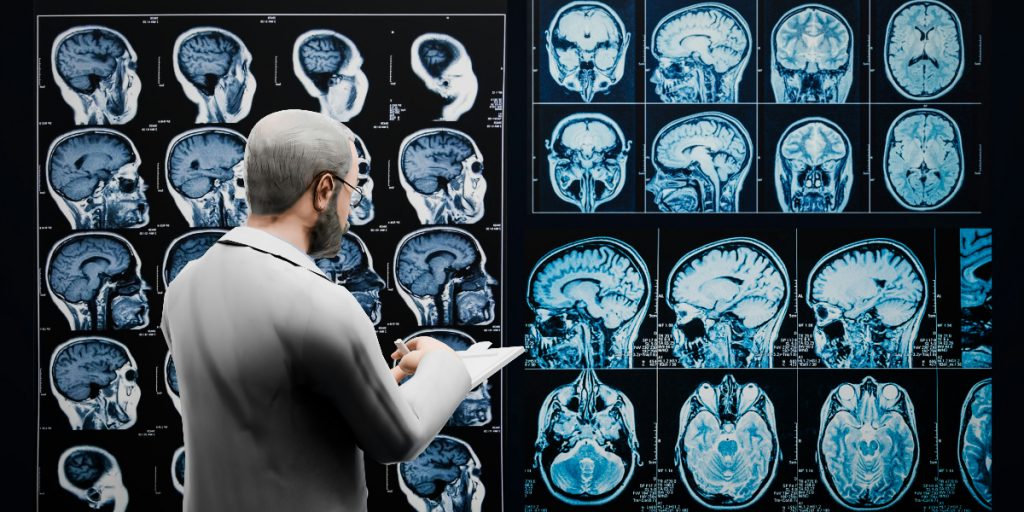Harry Cliff is a particle physicist based at the University of Cambridge and carries out research with the LHCb experiment at CERN’s Large Hadron Collider. He was a curator at the Science Museum, London for seven years and regularly gives public lectures and makes TV and radio appearances.
Below, Harry shares five key insights from his new book, Space Oddities: The Mysterious Anomalies Challenging Our Understanding of the Universe. Listen to the audio version—read by Harry himself—in the Next Big Idea App.

1. Our theory of the universe may need rewriting.
We’ve learned a huge amount about the universe over the past century, from the realization that it began with the Big Bang 13.8 billion years ago to the fact that the cosmos appears to be dominated by utterly mysterious substances called dark matter and dark energy. All this knowledge is encapsulated by a theory known as the standard cosmological model, which is based on Einstein’s general theory of relativity. So far, this model seems to describe the history of the universe from the Big Bang to the present day pretty well, but in the past few years, evidence has been growing that we may be missing something big.
Measurements of how fast the universe is expanding are in conflict with the predictions of the standard cosmological model—in other words, galaxies are flying away from us faster than we can currently explain. Meanwhile, studies of the distribution of galaxies throughout the cosmos have revealed that the universe is less “clumpy” than predicted—in other words, gravity has caused less structure to form than we’d expect. Together, these anomalies suggest that the cosmos is being sculpted by new forces or forms of energy that we haven’t yet discovered, which, if confirmed, would force us to rewrite our basic cosmological theory. Perhaps most excitingly, these discrepancies could be the first clues to what makes up the dark universe—the invisible 95 percent of everything made of dark matter and dark energy, which we know almost nothing about.
2. Small clues can lead to big discoveries.
The American science fiction author Isaac Asimov once wrote that the most exciting phrase to hear in science isn’t “Eureka!” (I found it!) but, “That’s funny…” Clues to many of the biggest breakthroughs in the history of science were found in tiny discrepancies that might easily have been missed or dismissed.
A great example of this was a strange anomaly in the orbit of the planet Mercury. In the 19th century, astronomers were repeatedly embarrassed by the scorched little world when they kept missing its transits across the face of the Sun, sometimes by hours, and in one extreme case by an entire day. A planet with such poor timekeeping was extremely disturbing in a universe that was supposed to run like clockwork according to Newton’s law of gravity.
“The clue lay in that one-in-12-million anomaly.”
To solve the problem, the French astronomer Urbain Le Verrier suggested that an unseen planet between Mercury and the Sun was tugging on Mercury, explaining why it kept showing up early for transits. This planet, known as “Vulcan,” was even discovered by a French amateur astronomer before being undiscovered several decades later. However, the problem with Mercury’s orbit remained. The effect was tiny—Mercury was effectively completing one extra orbit every 12 million Mercurian years, but it still required an explanation.
The solution was far more profound than just a new planet. In 1915, Albert Einstein was completing what would prove to be his masterpiece—the general theory of relativity—a radical new description of space, time, and gravity. Shortly before he was ready to reveal his theory to the world, Einstein tested it by calculating the orbit of Mercury using his theory instead of Newton’s law of gravity. General relativity accounted for the anomaly in Mercury’s orbit almost perfectly, and Einstein was so excited that he had heart palpitations and had to lie down. General relativity would go on to transform our understanding of the universe, leading to the Big Bang theory, black holes, and gravitational waves, to name a few. The clue lay in that one-in-12-million anomaly.
3. You must not fool yourself.
Scientists want to discover new things about the world. It’s what gets us up in the morning. It’s why we spend years of our lives working long hours for relatively low pay. We work without job security, often in unhospitable environments like the edge of Antarctica, down a deep mineshaft, or in a grotty 1970s physics department with a leaking roof and asbestos walls. The desire to discover is strong, and while that keeps scientists going, it can also lead us astray.
This is particularly true when it comes to anomalies. As we’ve seen, they can be clues to major breakthroughs, but more often than not, they are red herrings caused by statistical flukes, experimental mishaps, or a calculational error. The history of science is littered with examples of people who pushed the evidence too far, claiming a momentous discovery based on flimsy evidence that later unraveled.
The discovery and eventual un-discovery of the planet Vulcan is a salutary example. It’s why Richard Feynman once said, “The first rule is you must not fool yourself, and you are the easiest person to fool.” Skepticism and caution, especially when it comes to your own work, are perhaps the most important qualities of a good scientist.
4. Mistakes can be the best teacher.
Much of my own research took place at the Large Hadron Collider, on an experiment called LHCb. The b in LHCb stands for “beauty,” which is the name of one of the quarks, a family of fundamental particles, some of which make up the world around us. The experiment studies beauty quarks that get created in the LHC’s high-energy collisions to better understand the forces and particles in nature. For several years, we were seeing anomalies in the way these beauty quarks decay, and it seemed as though we might be seeing evidence of a new force. Of course, that would have been massively exciting.
“Science doesn’t make progress in a straight line.”
However, a few years ago, we discovered a hidden background interfering with some of our measurements. Realizing that we’d made a mistake was horrifying. As an experimentalist, the worst thing you can do is put a result out into the world that is wrong. Once we corrected the mistake, some of the anomalies disappeared. It was a very difficult process to go through, but it taught me a lot about the scientific process. Even when you’ve done everything you can think of to make the most accurate measurement you can, you can always miss something. Science doesn’t make progress in a straight line; there are missteps and wrong turns.
However, making mistakes is also one of the best ways to learn. Unraveling the issue taught us a lot about how our experiment works. Even though the results were spurious, they stimulated theorists to develop new ideas that continue to be interesting and may have applications in the future. It’s like the quote my old university tutor used to have stuck above his desk: “I’ve learned so much from my mistakes, I think I’ll make another.”
5. Experiment leads the way.
We love to celebrate theoretical geniuses like Einstein or Hawking in popular science accounts but tend to overlook the way most scientific progress is made—through experiment and observation. The idea of a single brilliant individual conjuring deep truths about the universe through sheer force of intellect is definitely romantic, but it’s the long, hard slog of designing, building, and carrying out experiments that yields the deepest insights.
In my own subject, particle physics, we’ve entered a phase where theory is no longer giving us a clear steer for where to look next. For some, that’s been disorienting, but personally, I find it exhilarating. After decades of confirming theoretical predictions, we’re now off the edge of the map, feeling our way through an unknown landscape, which is a tremendously exciting place to be. These experimental anomalies are the kinds of clues that will show us the way to a deeper understanding of the universe.
To listen to the audio version read by author Harry Cliff, download the Next Big Idea App today:































